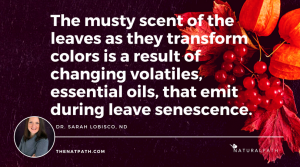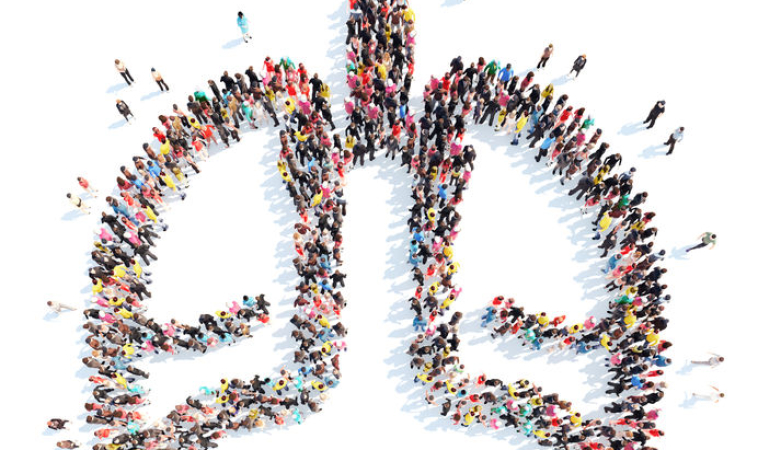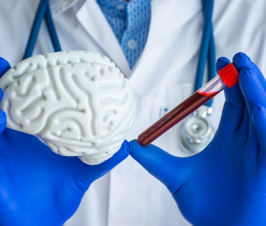The Healing Scents of Fall
 A few weeks ago, I posted an article that describes “Four Ways that Autumn Embraces Us with its Aromas of Health and Well-being.” In it, I discussed how our exposure to distinct fall odors provides evidence for the kindness of mother nature, our innate knowledge to thrive, and the wisdom of certain winter traditions.
A few weeks ago, I posted an article that describes “Four Ways that Autumn Embraces Us with its Aromas of Health and Well-being.” In it, I discussed how our exposure to distinct fall odors provides evidence for the kindness of mother nature, our innate knowledge to thrive, and the wisdom of certain winter traditions.
Many may think that their pumpkin pie latte’ is just a delightful, aroma-enticing, treat. However, the powerful spices that add flavor to our favorite Halloween-themed beverage have powerful immune supporting properties. Furthermore, the musty scent of the leaves as they transform colors isn’t just a poignant scent that invokes memories for the cozy times ahead. It is a result of changing volatiles, essential oils, that emit during leave senescence. These essential oils support the body, mind, and spirit in many ways.Their holistic healing properties make them helpful aids for the more demanding holiday prep work ahead.
You can read more about how the fall odors enhance our health and help us avoid the critter invasion that is more common during the season of sniffles here.
In this blog series, I will focus on another mechanism of action for respiratory and wellness protection of essential oils, beyond our noses. Specifically, I will highlight the underrecognized, underappreciated, lung microbiome.
Before I start with this specific group of critters in our lungs, let me give a brief general overview of the microbiome.
Bugs in Our Bodies
If essential oils are my first love, the microbiome (the microbiota cells and their genetic material) is a close second. Tie the 2 together, (which I’ve done here), and it’s like a holiday treat for me year-round!
The fascination for our un-human inhabitants began with the Human Microbiome Project (HMP), which sought to study the impact of the sum of the microorganisms that live in and on our body. The HMP “characterized the microbial communities from 300 healthy individuals, across several different sites on the human body: nasal passages, oral cavity, skin, gastrointestinal tract, and urogenital tract.” Another goal was to try to determine if a core healthy microbiome existed in the population.1
…As crazy as it sounds, it was discovered that were trillions of microbes all over and inside us. Never did one guess they would have such a profound impact on all aspects of one’s health!1-5 In 2012, an article in Clinical Microbiology and Infection, entitled “The Microbiome As a Human Organ” expressed the future potential of these discoveries:2
The human organism is a complex structure composed of cells belonging to all 3 domains of life on Earth, Eukarya, Bacteria and Archaea, as well as their viruses. Bacterial cells of more than a thousand taxonomic units are condensed in a particle functional collective domain, the intestinal microbiome. The microbiome constitutes the last human organ under active research. Like other organs, and despite its intrinsic complexity, the microbiome is readily inherited, in a process probably involving ‘small world’ power-law dynamics of construction in newborns. Like any other organ, the microbiome has physiology and pathology, and the individual (and collective?) health might be damaged when its collective population structure is altered. The diagnostic of microbiomic diseases involves metagenomic studies. The therapeutics of microbiome-induced pathology include microbiota transplantation, a technique increasingly available. Perhaps a new medical specialty, microbiomology, is being born. 2
The Ever-Expanding Discoveries of the Impact of Microbes
As time passes, scientists continue to discover more clues on how these critters that reside in and on us, communicate with our own cells and impact disease processes. Initially deemed as only pathogenic pests, it seems that these trillions of bugs were misunderstood. They can also be our health-promoting friends. It’s no wonder that researchers and doctors have become practically obsessed with learning about them.
As the saying goes, “the more you know, the more you know you don’t know,” there is still so much to discover regarding the microbiome. For example, initially all the attention has been on bacteria; however, we are now beginning to realize the influence of the virome, the fungal microbiome, and parasites.6-8 Scientific journals are also reporting on sightings of various microbes in organ systems initially deemed germ-free. We are realizing we aren’t as sterile as once thought, nor were we born that way! In fact, bacteria has even been found in our brain, the brain microbiome.
The effect that the microbiome has on our health cannot be escaped, it surrounds us everywhere as we continue to explore this seemingly infinite topic. In fact, we literally can’t get away from it! Did you know that even the cleanest emit “microbial clouds?” This freaky fact will scare the buggers out of any germaphobe.
What we do know for certain is that keeping our microbes happy in our insideand outside is a good thing for health. It’s been found that we can positively impact our microbe residents through nurturing and diverse foods, stress relief, and exercise.
I’ve also discussed how essential oils are another unrecognized tool that can be used to benefit our microbiota, in our guts and brain! In the next blog, I want to discuss how they may also affect the bugs in our lungs. This makes for yet another mechanism on how the “common scents of nature” keep us healthy throughout the seasons.
References:
- HMP. About the HMP. NIH (National Institute of Health) Human Microbiome Project (HMP). Available at: https://hmpdacc.org/hmp/. Accessed October 30, 2017.
- Baquero F, Nombela C. The microbiome as a human organ. Clin Microbiol Infect. 2012 Jul;18 Suppl 4:2-4. doi: 10.1111/j.1469-0691.2012.03916.x.
- Shreiner AB, Kao JY, Young VB. The gut microbiome in health and in disease. Current opinion in gastroenterology. 2015;31(1):69-75. doi:10.1097/MOG.0000000000000139.
- Hall AB,Tolonen AC, Xavier RJ. Human genetic variation and the gut microbiome in disease [abstract]. Nat Rev Genet [online]. 2017 Nov;18(11):690-699. doi: 10.1038/nrg.2017.63.
- Cho I, Blaser MJ. The Human Microbiome: at the interface of health and disease. Nature reviews Genetics. 2012;13(4):260-270. doi:10.1038/nrg3182.
- Virgin, HW. The Virome in Mammalian Physiology and Disease.Cell.March 2014; 157(1): 142-150.
- Huffnagle GB, Noverr MC. The emerging world of the fungal microbiome. Trends in microbiology. 2013;21(7):334-341. doi:10.1016/j.tim.2013.04.002.
- Zaiss MM, Harris NL. Interactions between the intestinal microbiome and helminth parasites. Allen J, ed. Parasite Immunology. 2016;38(1):5-11. doi:10.1111/pim.12274.
Image Copyright: <a href=’https://www.123rf.com/profile_tai11′>tai11 / 123RF Stock Photo</a>
 Dr. Sarah LoBisco, ND, is a graduate of the University of Bridgeport’s College of Naturopathic Medicine (UBCNM). She is licensed in Vermont as a naturopathic doctor and holds a Bachelor of Psychology from State University of New York at Geneseo. Dr. LoBisco speaks professionally on integrative medical topics, has several journal publications, and has completed her postdoctoral training as a certified functional medicine practitioner. Dr. LoBisco currently incorporates her training in holistic medical practices and conventional medicine through writing, researching, private wellness consultations, and through her independent contracting work for companies regarding supplements, nutraceuticals, essential oils, and medical foods. Dr. LoBisco also enjoys continuing to educate and empower her readers through her blogs and social media. Her recent blogs about living naturally in our complex world and on the applications of essential oils can be found at www.dr-lobisco.com and at www.saratoga.com/living-well. Her new book BreakFree Medicine is now available on Amazon and Barnes & Noble’s.
Dr. Sarah LoBisco, ND, is a graduate of the University of Bridgeport’s College of Naturopathic Medicine (UBCNM). She is licensed in Vermont as a naturopathic doctor and holds a Bachelor of Psychology from State University of New York at Geneseo. Dr. LoBisco speaks professionally on integrative medical topics, has several journal publications, and has completed her postdoctoral training as a certified functional medicine practitioner. Dr. LoBisco currently incorporates her training in holistic medical practices and conventional medicine through writing, researching, private wellness consultations, and through her independent contracting work for companies regarding supplements, nutraceuticals, essential oils, and medical foods. Dr. LoBisco also enjoys continuing to educate and empower her readers through her blogs and social media. Her recent blogs about living naturally in our complex world and on the applications of essential oils can be found at www.dr-lobisco.com and at www.saratoga.com/living-well. Her new book BreakFree Medicine is now available on Amazon and Barnes & Noble’s.

















